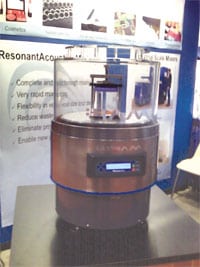 |
| The technology — now being demonstrated at the company’s booth with its lab-scale version (LabRAM) — generates acoustic waves via the resonant vibration of a simple, mechanically driven agitator. |
At an 11:00 a.m. press conference today, Resodyn Acoustic Mixers Inc. of Butte, Montana (Booth 211) will be hosting a demonstration of its new, impeller-free mixing technology, which induces microscale turbulence through the propagation of acoustic waves. Dubbed ResonantAcoustic Mixing (RAM), the now commercially available process promises solutions for many of the complications associated with conventional mechanical mixing: unwanted heat generation, due to excessive hydrodynamic shear stresses; long, inefficient mixing times; and impurities acquired during the transfer of products from mixing to shipping containers.
The technology — now being demonstrated at the company’s booth with its lab-scale version (LabRAM )— generates acoustic waves via the resonant vibration of a simple, mechanically driven agitator. According
to Resodyn’s website, the agitator system is kept on a resonant frequency by a “closely controlled electromechanical oscillator,” generating circular “intense mixing zones” each in the diameter range of 50–60 microns. In contrast to the bulk fluid flow induced by impeller mixing, which tends to localize mixing around regions near the impeller(s), the acoustic stream generates small eddies that are evenly dispersed throughout the process fluid. The vortices created homogenize process fluids faster while reducing shear stress and heat. “Not [just] a new product, but an entirely new technology,” according to Resodyn’s marketing manager Elyse Lewis, RAM is also distinct from ultrasonic methods in that its high-intensity sound energy occurs at a low-frequency (50–60 Hz) and is amenable to scaleup.
The technology — now being demonstrated at the company’s booth with its lab-scale version (LabRAM) — generates acoustic waves via the resonant vibration of a simple, mechanically driven agitator. According to Resodyn’s website, the agitator system is kept on a resonant frequency by a “closely controlled electromechanical oscillator,” generating circular “intense mixing Among the process’s ancillary benefits is the potential for previously prohibitive high-viscosity mixing. In one trial performed by Resodyn, a solid mixture of nano- and micron-sized powders was successfully mixed with a viscous polymer resin at an 80% solids loading in approximately 1 hour. Exhibiting a viscosity in excess of 100M cP, the material had been unmixable with prior methods. Additionally, as ResonantAcoustic Mixing is noninvasive, it is also safer and more hygienic, allowing both toxic materials and contaminant-sensitive products to be mixed in their sealed containers without the risk of exposure. Though widely applicable, this aspect is of particular use to the biotech and pharmaceuticals sector, where the incidental effects of both ultrasound and mechanical impellers can also cause damage to the active cellular material.
The LabRAM to be demonstrated comes with an adjustable vessel holder designed to accept vessels ranging in volume from 6 to 16 oz with a maximum weight of 500 g. Resodyn’s LabRAMs can be rented for offsite trials and are available in a vacuum chamber model. The company plans to offer a 5-gal mixer (RAM 5) by the end of 2007 and a 55-gal mixer in 2008. Mixing trials can also be scheduled onsite with a large-scale demonstration mixer, which can mix up to 30 gal.